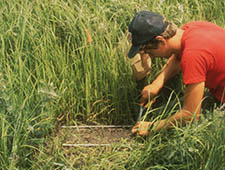
Nitrogen enrichment can dramatically change the existing environment for plants and typically leads to increased productivity, decreased diversity, and shifts plant community composition. But what mechanisms are responsible for these changes? Researchers designed a multi-site experiment to find out, experimentally manipulating each of three possible drivers across mesocosms of three ecosystem types (tall grass prairie, alpine tundra, and desert grassland).
High nitrogen availability (1) reduces competition for nutrients and increases the struggle for light, so that even a small difference in size can (2) amplify a plant’s competitive ability (asymmetric competition). Abundant nitrogen also (3) changes the community composition of soil microbes and fungi, which in turn alters plant community structure via species-specific feedbacks.
Researchers found that resource limitation strongly affected plant growth in all systems. In prairie and alpine systems, asymmetric competition drove diversity declines, while microbes were the driving force in desert grasslands. Species composition responded to a combination of different factors in each type of ecosystem. If this framework proves broadly applicable, it could give scientists a tool for tailoring strategies to management priorities.










